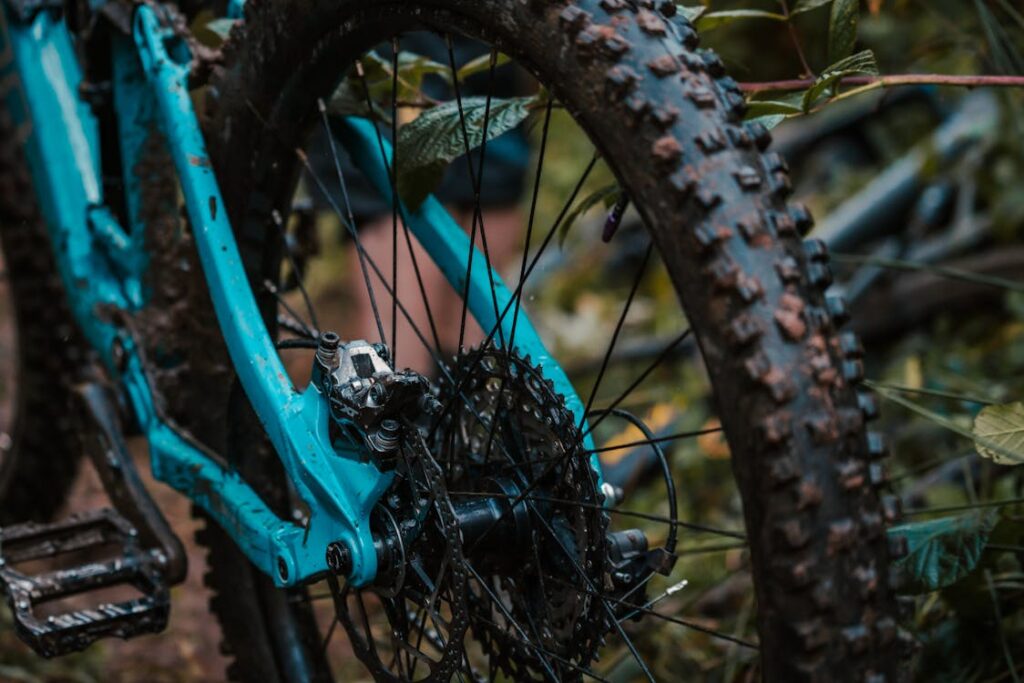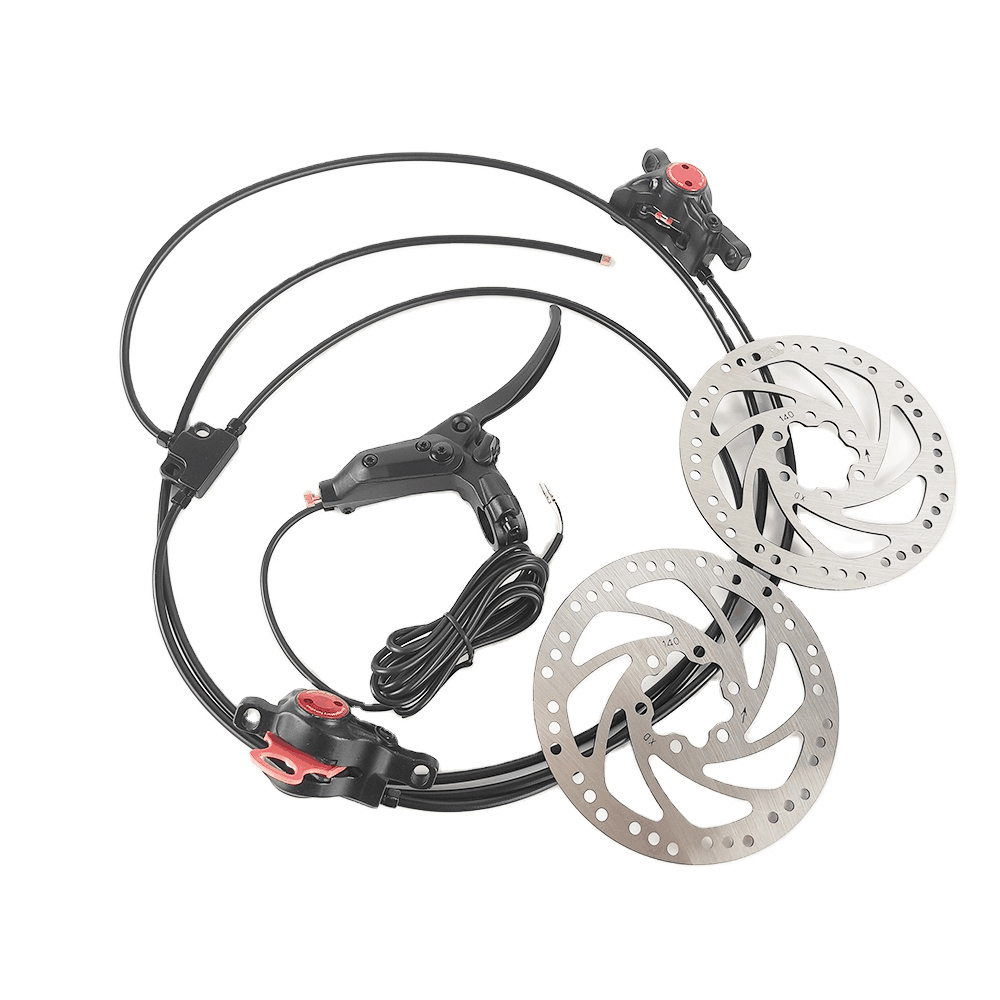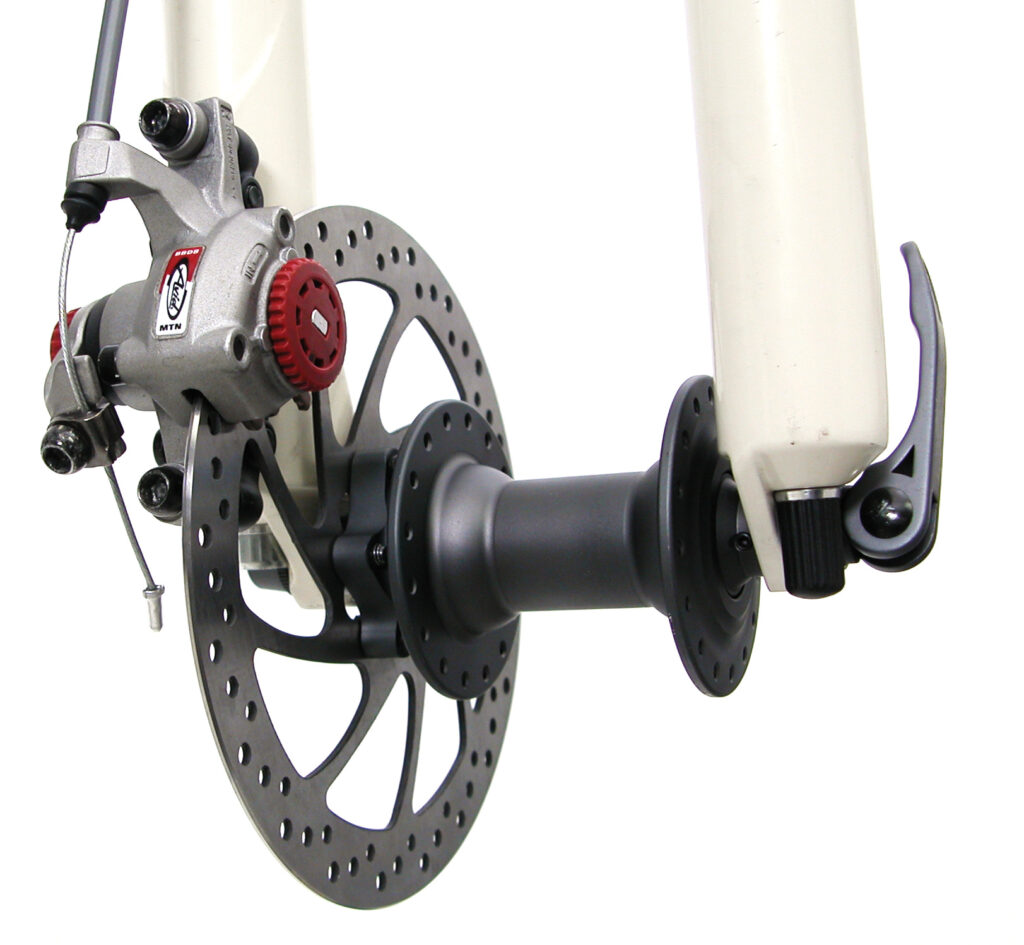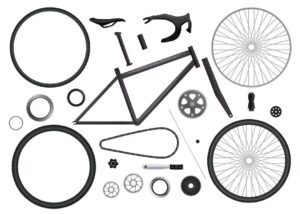사이클링 및 자동차 공학 분야, 유압 브레이크와 기계식 브레이크 사이의 논쟁은 오랫동안 관심과 논쟁의 주제였습니다.. 각 브레이크 시스템에는 뚜렷한 장점과 단점이 있습니다., 매니아와 전문가 모두가 차이점과 응용 프로그램을 이해하는 것이 중요합니다..

유압 디스크 브레이크란??

유압식 디스크 브레이크는 유압유 압력을 활용하여 브레이크 레버에서 휠의 제동 메커니즘으로 힘을 전달하는 고급 브레이크 시스템입니다., 뛰어난 저지력 제공, 조정, 신뢰성, 특히 까다로운 조건에서. 예를 들어, 샤인순 TP-150049E 화물 전기 세발자전거를 위한 최고의 예산 유압 디스크 브레이크 중 하나입니다.. 높은 열 분산성과 내열성을 자랑합니다..
유압 브레이크 작동 원리?
유압 브레이크는 유체가 채워진 튜브와 실린더로 구성된 폐쇄 시스템을 통해 작동합니다.. 브레이크 레버를 눌렀을 때, 핸들바 근처에 위치한 마스터 실린더 내부의 피스톤에 힘을 가합니다.. 이 동작은 마스터 실린더 내의 브레이크액 압력을 증가시킵니다..
가압된 브레이크액은 호스나 튜브를 통해 휠에 있는 브레이크 캘리퍼로 강제 전달됩니다.. 캘리퍼 내부, 일부 피스톤에는 브레이크액도 포함되어 있습니다.. 가압된 유체가 캘리퍼에 도달하면, 이 피스톤을 바깥쪽으로 밀어냅니다..
피스톤이 바깥쪽으로 움직이면 브레이크 패드가 마모됩니다., 캘리퍼 내부에 위치한, 로터에 압착하기 (디스크 브레이크의 경우) 아니면 림 (림 브레이크의 경우). 이 접촉은 패드와 제동 표면 사이에 마찰을 발생시킵니다., 바퀴의 회전을 늦추거나 멈추게 하는 장치.
유압 브레이크의 구성 요소
유압 브레이크는 서로 원활하게 작동하는 여러 주요 구성 요소로 구성됩니다.:
브레이크액
유압 시스템은 특수하게 제조된 브레이크액을 사용합니다., 종종 글리콜 기반, 비압축성이며 압력을 효과적으로 전달합니다..
마스터 실린더
마스터 실린더는 브레이크 레버의 기계적 힘을 유압으로 변환합니다., 제동 과정 시작.
브레이크 캘리퍼
브레이크 캘리퍼에는 브레이크 패드를 로터에 밀어 넣는 피스톤이 들어 있습니다., 수압을 기계적 힘으로 변환하여 바퀴를 정지시키는 것.
유압 브레이크의 장점
유압식 브레이크는 기계식 브레이크에 비해 여러 가지 장점을 제공합니다.:
- 향상된 성능: 더욱 정밀한 변조와 더욱 강력한 저지력 제공.
- 더 나은 열 관리: 지속적으로 과도하게 사용하면 브레이크가 퇴색되는 경향이 적습니다..
- 최소한의 유지보수: 자체 조정 패드와 밀봉된 시스템으로 유지 관리가 줄어듭니다..
유압 브레이크의 단점
장점에도 불구하고, 유압 브레이크에는 몇 가지 제한 사항이 있습니다.:
- 복잡성: 유지보수 및 수리를 위해서는 전문적인 도구와 지식이 필요합니다..
- 잠재적인 유체 문제: 성능에 영향을 미칠 수 있는 유체 누출에 취약함.
- 비용: 기계식 브레이크에 비해 초기 설정 및 수리 비용이 더 높습니다..
기계식 브레이크란??

기계식 브레이크는 물리적인 메커니즘을 사용하는 브레이크 시스템입니다., 케이블과 같은, 브레이크 레버의 힘을 휠의 브레이크 메커니즘으로 전달합니다., 이러한 목적으로 유체 압력을 사용하는 유압 브레이크와는 반대로.
기계식 브레이크의 작동 원리?
기계식 브레이크는 케이블과 레버 시스템을 통해 작동하여 제동력을 가합니다.. 라이더가 브레이크 레버를 당기면, 연결된 케이블이 장력이 가해짐. 이 케이블은 레버에서 휠의 제동 장치까지 이어집니다..
휠엔드에서, 케이블은 브레이크 패드나 슈를 브레이크 표면과 접촉시키는 메커니즘에 연결됩니다.. 예를 들어, 디스크 브레이크에서, 케이블을 당기면 브레이크 캘리퍼가 브레이크 패드를 디스크 로터에 압착하게 됩니다., 바퀴의 속도를 늦추거나 멈추게 하는 마찰 생성. 림 브레이크에서는, 케이블은 휠 림에 대해 브레이크 패드를 누르는 메커니즘을 당깁니다., 마찰을 통해 동일한 제동 효과 달성.
적용되는 제동력의 양은 라이더가 브레이크 레버에 가하는 힘에 정비례합니다.. 기계식 브레이크는 단순성과 신뢰성으로 잘 알려져 있습니다., 복잡한 유압 시스템이나 유체에 의존하지 않기 때문입니다.. 하지만, 최적의 성능을 유지하려면 주기적인 조정이 필요할 수 있습니다., 시간이 지남에 따라 케이블이 늘어나 제동 효율성에 영향을 미칠 수 있기 때문입니다..
기계식 브레이크의 구성요소
기계식 브레이크는 기계적 이점을 위해 설계된 간단한 구성 요소로 구성됩니다.:
브레이크 케이블
내구성이 뛰어난 강철 케이블이 브레이크 레버를 제동 메커니즘에 연결합니다., 레버를 눌렀을 때 힘이 전달됨.
브레이크 레버
브레이크 레버는 라이더의 접촉점 역할을 합니다., 기계적 힘을 케이블 장력으로 변환.
브레이크 패드
기계식 브레이크는 로터나 림을 누르는 브레이크 패드를 사용합니다., 바퀴를 느리게 하거나 멈추기 위해 마찰을 발생시킵니다..
기계식 브레이크의 장점
기계식 브레이크는 특정 응용 분야에 적합한 뚜렷한 이점을 제공합니다.:
- 간단: 전문 도구 없이도 더 쉬운 설정 및 유지 관리.
- 신뢰할 수 있음: 유체 누출이나 유압 고장과 같은 문제가 발생할 가능성이 적습니다..
- 비용 효율적: 낮은 초기 비용과 손쉬운 수리로 경제성에 기여.
기계식 브레이크의 단점
하지만, 기계식 브레이크에는 성능에 영향을 미칠 수 있는 제한 사항도 있습니다.:
- 더 적은 전력: 일반적으로 유압 시스템에 비해 제동력이 낮습니다..
- 수동 조정: 케이블과 패드를 주기적으로 조정해야 함.
- 마모되기 쉬움: 시간이 지남에 따라 케이블이 늘어나거나 마모되면 제동 효율성에 영향을 줄 수 있습니다..
유압식 디스크 브레이크와 기계식 디스크 브레이크: 비교 분석
유압식 디스크 브레이크와 기계식 디스크 브레이크 중에서 선택할 때, 특정 요구 사항에 가장 적합한 옵션을 결정하려면 여러 가지 요소를 고려해야 합니다.. 유압식 디스크 브레이크와 기계식 디스크 브레이크를 차트 형식으로 비교 분석한 내용입니다.:
| 측면 | 유압 디스크 브레이크 | 기계식 디스크 브레이크 |
| 작동원리 | 힘을 전달하기 위해 유압유를 사용합니다.; 피스톤 구동 메커니즘 | 힘을 전달하기 위해 케이블과 기계적 지렛대를 사용합니다. |
| 변조 및 제어 | 뛰어난 변조 및 정밀한 제어 | 변조는 다양할 수 있음; 정확한 제어를 위해서는 더 많은 노력이 필요할 수 있습니다. |
| 정지 전원 | 강한, 일관된 제동력 | 일반적으로 충분한 제동력을 제공합니다., 그러나 유압보다는 적다 |
| 유지 | 가끔 수액 검사와 출혈이 필요함 | 주기적인 케이블 조정 및 패드 정렬 필요 |
| 내구성 | 밀폐형 시스템으로 요소에 대한 노출 감소; 내구성이 뛰어난 부품 | 케이블 마모 및 늘어짐에 따라 달라질 수 있음; 정기적인 유지 관리가 필요합니다 |
| 복잡성 | 유압 구성요소로 인해 더욱 복잡해졌습니다. | 더 적은 수의 구성 요소로 더욱 단순한 디자인 |
| 비용 | 초기 비용이 높음; 유지 관리 비용이 많이들 수 있습니다 | 초기 비용 절감; 유지보수 및 수리 비용은 일반적으로 저렴합니다. |
| 설치 용이성 | 적절한 설정을 위해서는 전문 지식이 필요합니다. | 더욱 쉬워진 설치; 기본 도구를 사용하여 조정이 가능합니다. |
| 적당 | 고성능 응용 분야 및 까다로운 조건에 이상적 | 레크리에이션 및 중간 정도 사용 용도에 적합 |
| 일반적인 응용 | 산악자전거, 고성능 차량 | 통근용 자전거, 보급형 자전거 |
더 낫습니다? 유압식 또는 기계식 디스크 브레이크
우수한 제동 시스템을 결정하는 것은 사용 상황에 따라 다릅니다.:
전문가용
경쟁적인 사이클링 또는 고성능 차량에서, 유압식 디스크 브레이크는 확실히 우수합니다.:
- 성능 요구 사항: 비교할 수 없는 제동력과 제어력을 제공합니다..
- 신뢰할 수 있음: 극한 상황에서도 일관된 성능으로 안전성 향상.
일상적인 사용을 위해
일상적인 자전거 이용자 및 레저용 차량용, 기계식 디스크 브레이크는 실용적인 이점을 제공합니다.:
- 경제성: 초기 비용이 낮고 유지 관리가 간단해 일반 라이더에게 적합합니다..
- 사용 편의성: 전문 지식 없이도 사용자 친화적인 조정 및 수리 가능.
결론
결론적으로, 유압 브레이크와 기계식 브레이크 사이의 선택은 특정 요구 사항과 우선 순위에 따라 결정됩니다.:
- 성능: 유압 브레이크는 힘과 정밀도가 뛰어납니다..
- 간단: 기계식 브레이크는 신뢰성과 비용 효율성을 제공합니다..
최고의 성능을 추구하는 전문 사이클리스트이든, 유지 관리의 용이성을 우선시하는 일반 라이더이든 상관없습니다., 브레이크 시스템 이해하기’ 미묘한 차이로 인해 정보에 입각한 결정을 내릴 수 있습니다.. 각 시스템에는 장점이 있습니다., 현대 사이클링 및 자동차 산업의 요구에 따라 계속해서 발전하는 다양한 제동 기술 환경에 기여합니다..
FAQ
Q1: 기계식 브레이크보다 유압식 브레이크가 더 좋나요??
일반적으로 유압 브레이크는 제동력이 더 강하기 때문에 기계식 브레이크보다 우수한 것으로 간주됩니다., 정확한 변조, 까다로운 조건에서의 신뢰성. 하지만, 더 간단하고 저렴한 기계식 브레이크에 비해 초기 비용이 더 높고 더 전문적인 유지 관리가 필요합니다..
Q2: 기계식 브레이크에 비해 유압식 브레이크의 주요 장점은 무엇입니까??
유압 브레이크는 뛰어난 제동력을 제공합니다., 더 나은 변조, 일관된 성능.
Q3: 유압 브레이크는 기계식 브레이크에 비해 유지관리가 더 어렵습니다.?
예, 유압 브레이크는 주기적인 유체 점검이 필요하며 출혈이 필요할 수 있습니다., 기계식 브레이크는 정기적인 케이블 조정이 필요합니다..
Q4: 레크리에이션 자전거 운전자에게 더 적합한 브레이크 유형은 무엇입니까??
기계식 브레이크는 초기 비용이 낮고 유지 관리 요구 사항이 간단하기 때문에 레크리에이션 용도로 선호되는 경우가 많습니다..
Q5: 기계식 브레이크보다 유압식 브레이크가 선호되는 시나리오는 무엇입니까??
유압 브레이크는 산악 자전거나 경주와 같은 고성능 작업에 탁월합니다., 정밀한 제어와 최대 제동력이 중요한 곳.

















